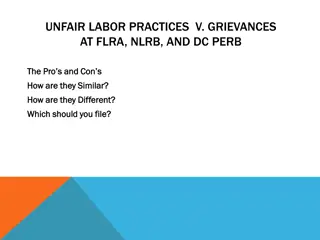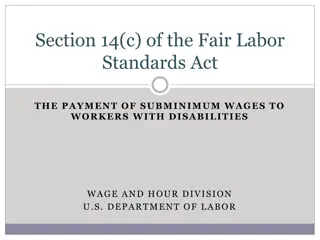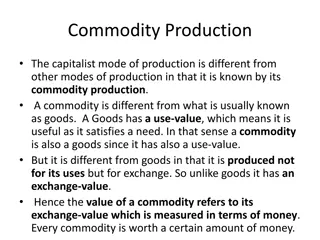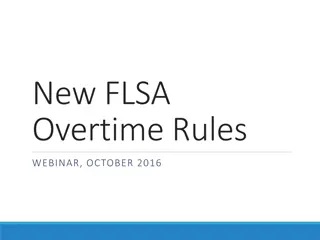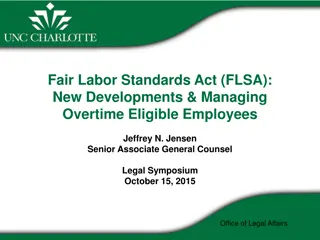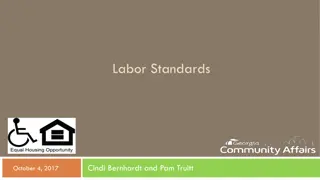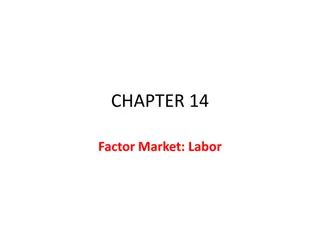Understanding the Fair Labor Standards Act (FLSA) in the US
The Fair Labor Standards Act (FLSA), administered by the U.S. Department of Labor, sets standards for minimum wage, overtime pay, youth employment, and recordkeeping. It distinguishes between employees and independent contractors based on the nature of their relationship with employers, with coverage extending to over 143 million workers in various workplaces, both at the enterprise and individual levels. The Act applies economic realities factors to determine employment relationships, with no specific rule for classification.
Download Presentation

Please find below an Image/Link to download the presentation.
The content on the website is provided AS IS for your information and personal use only. It may not be sold, licensed, or shared on other websites without obtaining consent from the author. Download presentation by click this link. If you encounter any issues during the download, it is possible that the publisher has removed the file from their server.
E N D
Presentation Transcript
Fair Labor Standards Act Presented by the U.S. Department of Labor Wage and Hour Division
Major Provisions Employment Relationship Coverage Minimum Wage Overtime Pay Youth Employment Recordkeeping
Employee or Independent Contractor? In order for the FLSA to apply, there must be an employment relationship between the employer and the employee The economic reality of the worker s relationship with the employer determines whether the worker is economically dependent on the employer (an employee), or is in business for himself or herself (an independent contractor)
Determining Employment Relationship The Supreme Court has indicated there is no single rule or test for determining whether an individual is an independent contractor or an employee for purposes of the FLSA. Courts generally apply a number of economic realities factors as guides when making the determination, but the factors applied can vary and no one set of factors is exclusive
Coverage More than 143 million workers in more than 9.8 million workplaces are protected or covered by the Fair Labor Standards Act (FLSA), which is enforced by the Wage and Hour Division of the U.S. Department of Labor
Coverage Two types of coverage Enterprise coverage: If an enterprise is covered, all employees of the enterprise are entitled to FLSA protections Individual coverage: Even if the enterprise is not covered, individual employees may be covered and entitled to FLSA protections
Enterprise Coverage Enterprises with At least two (2) employees engaged in commerce or producing or handling goods that have moved in commerce At least $500,000 a year in business Hospitals, businesses providing medical or nursing care for residents, schools, preschools and government agencies (federal, state, and local)
Individual Coverage Workers who are engaged in: Interstate commerce; Production of goods for commerce; Closely-related process or occupation directly essential (CRADE) to such production; or Domestic service Engaging in interstate commerce, which may include: Making telephone calls to other states Typing letters to send to other states Processing credit card transactions Traveling to other states
The Bottom Line Almost every employee in the United States is covered by the FLSA
Hours Worked: Issues Suffered or Permitted Waiting Time On-Call Time Meal and Rest Periods Training Time Travel Time Sleep Time
Suffered or Permitted Any work suffered or permitted is work time, even if it was not requested
Waiting Time Counted as hours worked when Employee is unable to use the time effectively for his or her own purposes; and Time is controlled by the employer Not counted as hours worked when Employee is completely relieved from duty; and Time is long enough to enable the employee to use it effectively for his or her own purposes
On-Call Time On-call time is hours worked when Employee has to stay on the employer s premises Employee has to stay so close to the employer s premises that the employee cannot use that time effectively for his or her own purposes On-call time is not hours worked when Employee is required to carry a pager or cell phone Employee is required to leave word at home or with the employer where he or she can be reached
Meal and Rest Periods Meal periods are not hours worked when the employee is completely relieved of duties for the purpose of eating a meal Rest periods of short duration (normally 5 to 20 minutes) are counted as hours worked and must be paid
Training Time Time employees spend in meetings, lectures, or training is considered hours worked and must be paid, unless Attendance is outside regular working hours Attendance is voluntary The course, lecture, or meeting is not job related The employee does not perform any productive work during attendance
Travel Time Ordinary home to work travel is not work time Travel between job sites during the normal work day is work time Special rules apply to travel away from the employee s home community
Sleep Time Less than 24 hour duty: Employee who is on duty for less than 24 hours is considered to be working even if allowed to sleep or engage in other personal pursuits Duty of 24 hours or more: Parties can agree to exclude bona fide sleep and meal periods of not more than 8 hours If the employee cannot get at least 5 hours sleep, the entire sleeping period is counted as working time
Recordkeeping The FLSA requires that all employers subject to any provision of the Act make, keep, and preserve certain records. Time clocks are not required and records need not be kept in any particular form. Nonetheless, every covered employer must keep certain records for each non-exempt worker
Recordkeeping Basic records that a covered employer must keep for each non-exempt worker: Full Name, sex, social security number, age (if younger than 19); Regular rate of pay, total hours worked, total daily or weekly straight-time earnings Deductions and date of payment and pay period for payment, etc.
Recordkeeping An accurate record of the hours worked each day and total hours worked each week is critical to avoiding compliance problems.
Required Posting Covered employers must post a notice explaining the FLSA, as prescribed by the Wage and Hour Division, in a conspicuous place
Minimum Wage: Basics Covered, non-exempt employees must be paid not less than the federal minimum wage for all hours worked The minimum wage is $7.25 per hour effective July 24, 2009 Cash or equivalent free and clear
Minimum Wage: Issues Compensation Included Deductions Tipped Employees Hours Worked
Compensation Included Wages (salary, hourly, piece rate) Commissions Certain bonuses Tips received by eligible tipped employees (up to $3.72 per hour effective July 24, 2007; $4.42 per hour July 24, 2008; and $5.12 per hour July 24, 2009) Reasonable cost of room, board and other facilities provided by the employer for the employee s benefit
Reasonable Cost Cannot exceed actual cost Cannot include a profit to the employer Employer s method of determining reasonable cost should follow good accounting practices Employer cannot take a credit when no cost is incurred
Deductions Deductions from pay illegal if Deduction is for item considered primarily for the benefit or convenience of the employer; and The deduction reduces employee s earnings below required minimum wage Examples of illegal deductions Tools used for work Damages to employer s property Cash register shortages
Minimum Wage Example Employee receives $7 per hour for 40 hours plus $5 in commission and $20 in reasonable cost of board, lodging or other facilities Total earnings = $280 + $5 + $20 = $305 Total earnings/total hours $305/40 = $7.62
Tipped Employee Works in occupation in which he or she customarily and regularly receives more than $30 per month in tips Paid at least $2.13 in cash by employer, who may claim a tip credit for the rest of minimum wage
Tip Credit Employer may claim tip credit only if The employer informs each tipped employee about the tip credit allowance, including amount to be credited before the credit is utilized The employer can document that the employee received at least enough tips to bring the total wage paid up to minimum wage or more All tips are retained by the employee and are not shared with the employer or other employees, unless through a valid tip pooling arrangement
Overtime Pay Covered, non-exempt employees must receive one and one-half times the regular rate of pay for all hours worked over forty in a workweek
Overtime Issues Each workweek stands alone Regular rate Payments excluded from rate Payments other than hourly rates Tipped Employees Deductions
Workweek Compliance is determined by workweek, and each workweek stands by itself Workweek is 7 consecutive 24 hour periods (168 hours)
Regular Rate Is determined by dividing total earnings in the workweek by the total number of hours worked in the workweek May not be less than the applicable minimum wage (including state and local minimum wages)
Regular Rate Exclusions Sums paid as gifts Payments for time not worked Reimbursement for expenses Discretionary bonuses Profit sharing plans Retirement and insurance plans Overtime premium payments Stock options
White Collar Exemptions The most common FLSA minimum wage and overtime exemption -- often called the 541 or white collar exemption -- applies to certain Executive Employees Administrative Employees Professional Employees Outside Sales Employees Computer Employees
Three Tests for Exemption Salary Level Salary Basis Job Duties
Minimum Salary Level For most employees, the minimum salary level currently in effect for the exemption is $455 per week.
Salary Basis Test Regularly receives a predetermined amount of compensation each pay period (on a weekly or less frequent basis) The compensation cannot be reduced because of variations in the quality or quantity of the work performed Must be paid the full salary for any week in which the employee performs any work Need not be paid for any workweek when no work is performed
Deductions From Salary An employee is not paid on a salary basis if deductions from the predetermined salary are made for absences occasioned by the employer or by the operating requirements of the businesses If the employee is ready, willing and able to work, deductions may not be made for time when work is not available
Permitted Salary Deductions Seven exceptions from the no pay-docking rule 1.Absence from work for one or more full days for personal reasons, other than sickness or disability 2.Absence from work for one or more full days due to sickness or disability if deductions made under a bona fide plan, policy, or practice of providing wage replacement benefits for these types of absences 3.To offset any amounts received as payment for jury fees, witness fees, or military pay
Permitted Salary Deductions (continued) Seven exceptions from the no pay-docking rule (cont.) 4. Penalties imposed in good faith for violating safety rules of major significance Unpaid disciplinary suspension of one or more full days imposed in good faith for violations of written workplace conduct rules Proportionate part of an employee s full salary may be paid for time actually worked in the first and last weeks of employment Unpaid leave taken pursuant to the Family and Medical Leave Act 5. 6. 7.
Executive Duties Primary duty is management of the enterprise or of a customarily recognized department or subdivision Customarily and regularly directs the work of two or more other employees Authority to hire or fire other employees or recommendations as to the hiring, firing, advancement, promotion or other change of status of other employees given particular weight





